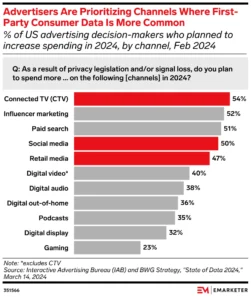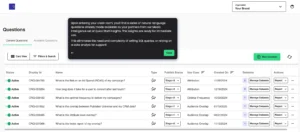Future-Proof Insights: 5 Ways Media Measurement is Changing

Proving the ROI of every marketing dollar is mission-critical, yet cross-platform ad measurement remains exceptionally hard to do well. As signal loss threatens targeting and attribution across the open web, roughly half of advertisers are prioritizing authenticated channels with logged-in audiences, according to a 2024 EMARKETER report. But, with different data formats and legal approvals across publishers, how can brands and media planners manage all these data variables?In a recent episode of EMARKETER’s "Behind the Numbers" podcast, industry experts explored how standardization might be the secret weapon that resolves this “analysis paralysis.” The conversation between LiveRamp's VP of Product Matthew Karasick, EMARKETER’s Senior Director of Podcasts and host Marcus Johnson, and Senior Analyst Max Willens reveals how marketers are finding ways to scale effective and responsible data use and measurement across platforms.

Signal loss has led an advertiser flight to channels with rich first-party data, according to a 2024 EMARKETER report.
Goodbye to the “Wild West” of brand marketing insights
Karasick likens 2025 to a "cold shower" moment for the industry – brand marketers have realized traditional data management practices are no longer sustainable. "We’re seeing a ton of fundamental changes in privacy, cloud computing, and data infrastructure,” he explains. “Throwing JavaScript tags on web pages or producing huge amounts of duplicated data to run your own methodology is no longer a viable path to insights." With such a fragmented media landscape, efficiency matters more than ever. Non-standardized approaches to cross media measurement and analytics lead to slower advertising decisions made without complete performance data.Without standardization, each new data collaboration between a brand and media company requires:
- Custom legal negotiations
- Unique data-sharing protocols
- Bespoke analysis frameworks
- Individual privacy controls
- Custom query code development
As Willens points out, "being in a place where every time you try to add to that stable of partners, you have to slog through a ton of mud... seems like it would drive everybody crazy." As a result, marketers are seeking an “easy button” for standardization to avoid repeating this process for every report.
5 key changes in media measurement and analytics
To find a more sustainable approach to marketing insights measurement, brands are adopting new tools to help streamline how they plan, optimize, and measure campaigns across channels and at scale.
1. The rise of decentralized data
As programmatic budgets migrate into walled gardens, Willens notes the rise of the “open-ish web.” Brands increasingly manage campaigns across a “coterie of partners,” seeking incremental ways to maximize audience reach or hunt for optimal results and growth. This transformation requires a complete rethinking of data strategy, from centralization to collaboration. As Karasick states, "No longer will any one party be able to get all of the data, put it in one single database, and do whatever they want with it. Data will stay in different clouds, formats, schemes, or technologies; that doesn't mean all parties can't opt their data in to be part of a use case that everyone has agreement on with transparency and control.”Data collaboration enables companies to effectively bridge those silos, harnessing decentralized data for specific use cases to drive better business outcomes. https://liveramp.wistia.com/medias/smcsxvh36x
2. Clean rooms are now mission-critical
Given the twin challenges of fragmentation and privacy, clean rooms have emerged as an essential technology for responsible customer data analysis. In these environments, embedded privacy and governance controls can allow two or more partners to securely make first-party data available for marketing activation or measurement, while helping to protect sensitive information with a clear audit trail.Data-driven brands like Hershey's see clean rooms as the foundation of their modern measurement and attribution strategies, enabling their marketing teams to:
- Transition to portfolio-level insights, analyzing data across brands
- Supplement limited first-party data with syndicated third-party data
- Validate retail media investments and improve media governance
As data privacy rules continue to evolve, clean rooms offer a new approach to insights, serving as the connective tissue between brands and walled gardens, CTV, social platforms, and other premium publishers.
3. Partners seek both data and agility
While measurement is more important than ever, most brands and agencies are still struggling to find quality partners for collaborating, enriching, and modeling data. Willens cited research from his colleague, EMARKETER analyst Evelyn Mitchell-Wolf, that explored US online privacy trends and the scramble to piece together consumers’ various data breadcrumbs. It's no longer enough for partners to simply possess valuable data or advanced analytical capabilities. As Willens notes, companies are increasingly focused on implementation timelines and operational efficiency, moving away from partnerships that require "two quarters to get implemented or worse."
4. Legal frameworks ease friction points
The movement toward common legal frameworks represents what Karasick calls "the simplest example" of how standardization creates value. Historically, if a media company wanted to let a marketer use their data for a campaign, each collaboration would require a new legal negotiation to determine scope and data rights. In this piecemeal approach, even the biggest marketing teams struggle to scale cross-media measurement and analytics.The solution? Pairing clean rooms with standardized terms, turnkey use cases, and language that multiple parties can readily adopt for the most fundamental marketing metrics. This approach can reduce a weeks- or months-long process into mere days. "It sounds so simple," says Karasick, "but I'm telling you it is countless calls, emails, and red lines removed from the process which I have watched slow things down or block things for weeks, months, or even quarters."https://liveramp.wistia.com/medias/1vfwqpgj06
5. Pre-built analytics speed up insights
Another major shift for marketers is the rise of no-code analytics. Traditionally, marketers have often relied on data scientists to get actionable campaign data. Even teams with ample resources can still struggle to find the best path to insights. Karasick shares a common scenario: "I have watched two parties come together with absolute mutual alignment... And still [squander] several, all-day working sessions of going through the spreadsheets where very smart analysts had put together lists of hundreds of queries that could be run."Templated clean room queries speed up the time to insights for every marketer, eliminating the need for robust data science resources to get baseline ad performance metrics. For example, LiveRamp’s Quick Start Insights for Media Intelligence offer what Karasick calls "a set of pre-packaged, pre-baked query and question templates that all marketers need to know to get a base-level understanding of what the opportunity is on planning, what's working well and what's not in the middle of a campaign, and what happened afterward."https://liveramp.wistia.com/medias/y2vzbn2q0oThese pre-built dashboards include cross-platform insights around audience overlaps, optimal frequency by campaign, and last-touch attribution.

Sample of pre-built queries offered in LiveRamp’s Quick Start Insights. See more in our interactive demo
The new approach to accelerate marketing insights
The marketing industry stands at a pivotal moment where collaboration, not isolation, will define long-term success. As brands, publishers, and technology partners work to overcome data fragmentation and evolving privacy requirements, industry-wide standardization offers a path that balances innovation with governance.For marketing leaders, the question isn't whether to embrace standardization, but how quickly they can begin the transformation. This cold shower moment may be unfamiliar, but it's leading to a much brighter future for faster and deeper marketing insights.Want to dive deeper into the future of marketing standardization? Listen to the full discussion on "Behind the Numbers", and explore our interactive demo to see pre-built analytics in action.
